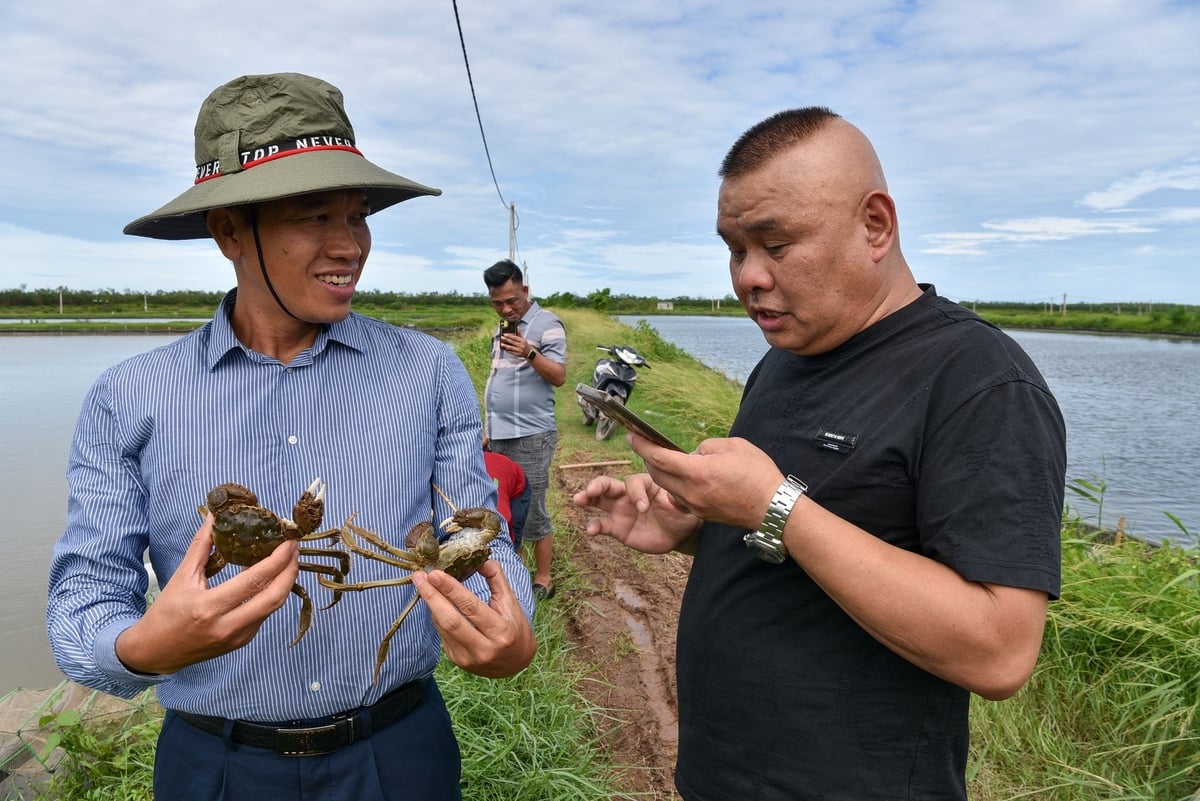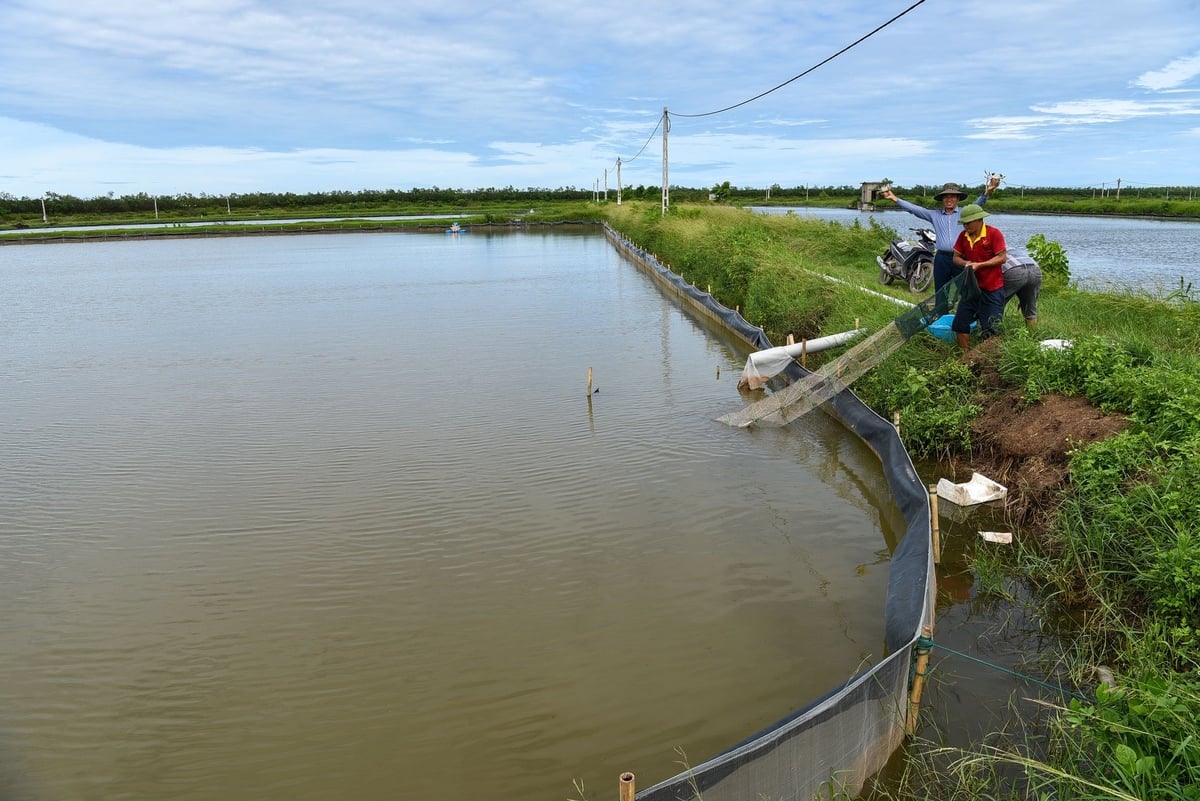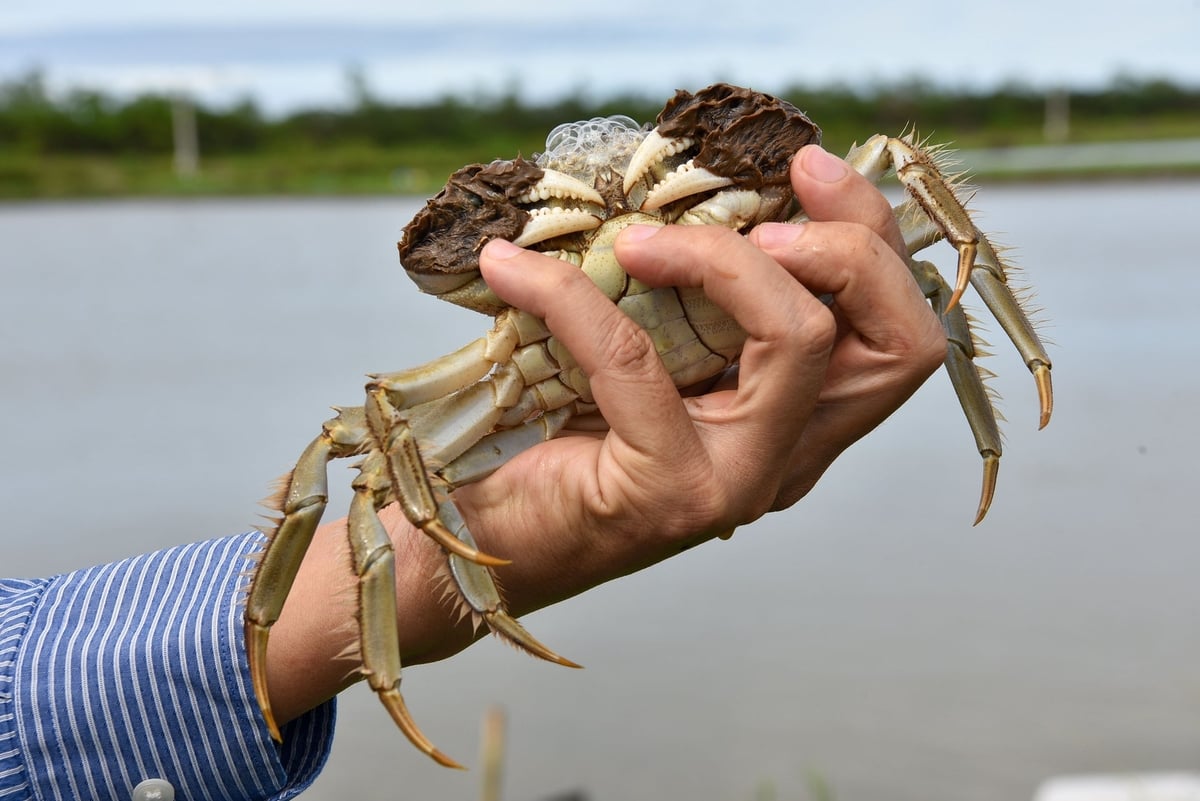December 4, 2025 | 15:41 GMT +7
December 4, 2025 | 15:41 GMT +7
Hotline: 0913.378.918
December 4, 2025 | 15:41 GMT +7
Hotline: 0913.378.918

Mr. Tran Van Van (left) introduces farmed hairy crabs in Hung Yen to Mr. Chau Duc Trung, a Chinese expert. Photo: Duong Dinh Tuong.
A year ago, when I expressed my interest in exploring the farming model of ca ra (hairy crab), Tran Van Van – Director of Minh Phu International Joint Stock Company (MICFOOD) – sincerely declined. He explained that the farming process was not yet complete and the results were not as expected, asking me to return in 2025. As promised, earlier this year, he invited me to visit the vast ca ra farming area in Nam Thinh, Tien Hai – formerly part of Thai Binh province, now merged into Hung Yen province.
Accompanying us was a special delegation from China led by Zhou Dezhong, a representative of Cheng Zhi Tai Company. Their visit aimed to explore Vietnam’s latest ca ra farming technologies and introduce advanced techniques from China, hoping to open up cooperation opportunities in the coming year.
We arrived in the early afternoon. The 108-hectare farm is located right in the estuary’s alluvial zone, where the Hong Ha River flows into the East Sea. The ponds are neatly arranged like chessboard squares, surrounded by lush mangrove forests. Previously, this area was mainly used for shrimp farming, but it has now been converted to hairy crab farming, requiring only minor modifications to the pond banks by lining them with plastic sheets to prevent the crabs from escaping.

Test harvesting hairy crabs using a multi-chamber net. Photo: Duong Dinh Tuong.
The ecosystem here is vibrant: flocks of herons and waterfowl fly overhead, while grasshoppers and crickets leap around on the ground. A worker lifted a trap net and poured a cluster of hairy crabs into a large basin. Zhou Dezhong picked up a few and exclaimed, “Vietnam is raising hairy crabs very well!”. Although they had only been farmed for five months and still needed to molt twice more to reach full size, each crab already weighed 150–200 grams on average. With good care, they can reach 300–350 grams when mature.
Remarkably, this species can thrive in both freshwater and brackish water. Even though freshwater is pumped into the ponds, the soil still contains a slight salinity. At times, the salinity reached up to 7.5‰, yet the crabs developed normally. This demonstrates the ca ra’s exceptional adaptability to artificial farming environments.
Mr. Van shared, “I’ve signed export contracts for ca ra to several international markets with volumes reaching thousands of tons. In China, hairy crabs weighing 200–350 grams are often retained for domestic consumption at very high prices. The ones previously exported to Vietnam were mostly smaller, second- or third-grade crabs.”
After his success with the freshwater fish chain "Da River Fish," farmed in hydropower and irrigation reservoirs, Mr. Van decided to expand into ca ra – a native species with high economic value. In March 2023, he began trial farming in Tu Ky district (formerly part of Hai Duong) on 7 hectares. However, due to a lack of mastery in technique and seed quality, the results fell short. The total output was only 3 tons, sold domestically at an average price of VND 500,000 per kilogram, yielding modest profits.

Mr. Tran Van Van with Chinese mitten crabs after 5 months of farming. Photo: Duong Dinh Tuong.
Undeterred, he traveled to China to learn from established models. In Jiangsu province, he visited Hao Nhuan Group – a leading hairy crab enterprise with more than 1,500 employees. They produce 80 tons of crab larvae annually (about 120,000 baby crabs per kilogram), accounting for nearly 20% of China’s hairy crab seed market. Additionally, they manufacture aquatic feed, farming medication, and process hairy crabs for export, with an annual processing output of up to 45,000 tons.
Vietnam is naturally home to hairy crabs, particularly in rivers across the northern and central regions. According to Mr. Van, if Vietnam can take the initiative in seed production and farming techniques, it could become a major ca ra exporter in the region. Since his trip to China, he has focused on in-depth research and has achieved some initial success. This year’s farming cycle is expected to yield 1 to 1.5 tons per hectare – a fairly impressive figure.
The breeding cycle of hairy crabs takes place in November and December, and by the following November or December, they can be transferred to commercial farming ponds. However, the most suitable time for stocking is January or February, with harvest in September. These crabs tolerate cold well and can survive in freezing water surfaces, but they cannot endure prolonged heat – if the water temperature exceeds 33°C for more than five days, they will weaken.

Purchase price of ca ra at local households ranges from VND 360,000 to VND 420,000 per kilogram depending on size. Photo: Duong Dinh Tuong.
Currently, in addition to the company’s 108-hectare farm, Mr. Van is partnering with farmers in various provinces to transfer seed and techniques to an additional 30 hectares. This sustainable production linkage model helps increase farmers’ incomes and harnesses the potential of freshwater areas.
Feed accounts for only 20–25% of the total cost, while the rest covers seed, pond improvement, labor, and electricity. Electricity alone – used to pump water and run oxygenation fans – costs VND 80 to 100 million monthly. To reduce costs, the company invests in a solar power system, aiming for long-term sustainability and energy independence in production.
Hairy crabs can only reproduce in the winter when the temperature drops below 18°C. Therefore, its natural distribution in Vietnam extends from the northern region to Hai Van Pass in central Vietnam, with a high concentration in major northern rivers such as the Hong, Ma, Thai Binh, Tra Ly, and Cau rivers.
* USD 1 = VND 26,335. Source: Vietcombank
Translated by Huong Giang

(VAN) As of 2025, the ASEAN region has a total of 69 ASEAN Heritage Parks recognized across its 10 member states. Among them, Viet Nam contributes 15 ASEAN Heritage Parks.

(VAN) Yok Don National Park has high biodiversity with numerous endemic plant and animal species, and it is also the only dipterocarp forest ecosystem conservation area in Viet Nam.

(VAN) Viet Nam and Brunei signed two important MOUs on fisheries and IUU, expanding cooperation in agriculture, the environment, and Halal exports, aiming to substantively implement joint projects.

(VAN) The Viet Nam Coconut Association worked with the International Finance Corporation (IFC) and businesses to promote the supply chain, enhance competitiveness, and develop the coconut industry sustainably.
![Hue aims for Net Zero: [2] Pioneering low-emission tourism](https://t.ex-cdn.com/nongnghiepmoitruong.vn/608w/files/huytd/2025/12/04/0633-dulichzero-4-095634_236-161125.jpg)
(VAN) The ancient capital of Hue has developed Net Zero tourism products and models, aiming to reduce carbon emissions and pioneer the establishment of Viet Nam's green tourism destination.

(VAN) C.P. Viet Nam has announced the successful completion of its goal to plant 1.5 million trees during the 2021-2025 period, a key milestone within company's long-term ESG strategy and its roadmap for emission reduction.

(VAN) This is an initiative of MAE aimed at creating a unified coordination mechanism to implement agricultural cooperation programs with developing countries.